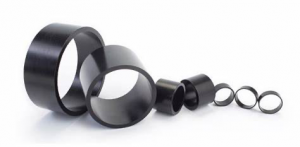Supplier: Gleetek Co., Ltd
Contact person: Ms. Heather May
Position: General Manager
Address: 914, Shangi Plaza, Yuhang, Hangzhou, Zhejiang China
Country: China
Phone: +8613738189892 - Mobi: +8613738189892
Bonded NdFeB
Price: 0.1
| Bonded NdFeB (Neodymium Iron Boron) magnets represent a significant advancement in magnetic material technology, offering exceptional magnetic properties combined with the flexibility of manufacturing complex shapes. These magnets are widely utilized in various industries due to their high magnetic strength, precision, and cost-effectiveness. In this comprehensive introduction, we will delve into the brief history, pros and cons, and ten main applications of Bonded NdFeB magnets. Brief History: The development of Bonded NdFeB magnets began in the late 20th century as a result of ongoing research to enhance the performance and versatility of permanent magnet materials. Unlike traditional sintered NdFeB magnets, which are manufactured through powder metallurgy techniques, bonded NdFeB magnets are produced by mixing NdFeB powder with a polymer binder and then compacting the mixture into the desired shape using compression or injection molding processes. This innovative manufacturing method enabled the production of magnets with intricate shapes and improved dimensional accuracy, expanding their range of applications across various industries. Pros and Cons: Pros: High Magnetic Strength: Bonded NdFeB magnets offer exceptional magnetic strength comparable to sintered NdFeB magnets, making them suitable for applications requiring strong magnetic fields. Complex Shapes: Unlike traditional magnet materials, bonded NdFeB magnets can be manufactured into complex shapes and configurations using injection molding techniques, allowing for greater design flexibility and customization. Cost-Effectiveness: The production of bonded NdFeB magnets involves less material waste and lower manufacturing costs compared to sintered NdFeB magnets, making them a cost-effective solution for certain applications. Corrosion Resistance: The polymer binder used in bonded NdFeB magnets provides a protective coating, enhancing their resistance to corrosion and oxidation in certain environments. Cons: Lower Magnetic Energy Product: Bonded NdFeB magnets typically have a lower magnetic energy product compared to sintered NdFeB magnets, limiting their suitability for applications requiring extremely high magnetic performance. Temperature Limitations: Bonded NdFeB magnets may exhibit reduced performance at elevated temperatures compared to sintered NdFeB magnets, necessitating careful consideration of operating conditions in high-temperature environments. Brittle Nature: While the polymer binder improves flexibility, bonded NdFeB magnets can still be brittle and prone to breakage if subjected to excessive mechanical stress or impact. Ten Main Applications: Electric Motors and Actuators: Bonded NdFeB magnets are widely used in electric motors, actuators, and servo systems for various applications such as automotive components, robotics, and consumer electronics, where high torque and precise control are essential. Magnetic Sensors: In automotive, industrial, and consumer electronics, bonded NdFeB magnets serve as crucial components in magnetic sensors for detecting and measuring magnetic fields, enabling applications such as position sensing, speed detection, and proximity sensing. Linear and Rotary Encoders: Bonded NdFeB magnets are utilized in linear and rotary encoders to provide accurate position feedback in machine tools, robotics, and motion control systems, enabling precise motion control and positioning. Magnetic Couplings: In pumps, compressors, and other rotating machinery, bonded NdFeB magnets are used in magnetic couplings to transmit torque through a non-magnetic barrier, offering hermetic sealing and preventing leakage. Loudspeakers and Headphones: Bonded NdFeB magnets are incorporated into loudspeakers and headphones to produce strong magnetic fields for efficient sound reproduction, delivering high-fidelity audio performance in consumer electronics. Magnetic Door Catches: In furniture, cabinets, and doors, bonded NdFeB magnets are employed as magnetic catches to secure doors and drawers, providing a reliable and convenient solution for household and commercial applications. Magnetic Clamps and Fixtures: Bonded NdFeB magnets are utilized in clamps, fixtures, and tool holders for temporary or permanent magnetic attachment in machining, welding, and assembly processes, facilitating efficient workholding and positioning. Magnetic Therapy Devices: Bonded NdFeB magnets are used in therapeutic devices for pain relief, rehabilitation, and wellness applications, where their strong magnetic fields are believed to provide beneficial effects on the body's tissues and cells. Magnetic Name Tags and Badges: In offices, conferences, and events, bonded NdFeB magnets are integrated into name tags, badges, and promotional items for convenient attachment to clothing without the need for pins or clips. Crafts and DIY Projects: Bonded NdFeB magnets find applications in various crafts, hobbies, and do-it-yourself (DIY) projects for creating magnetic closures, fixtures, and decorative elements, offering versatility and ease of use in creative endeavors. |
SEND INQUIRY
Please fill in fully your information to send email
CATEGORY














 Agriculture
Agriculture